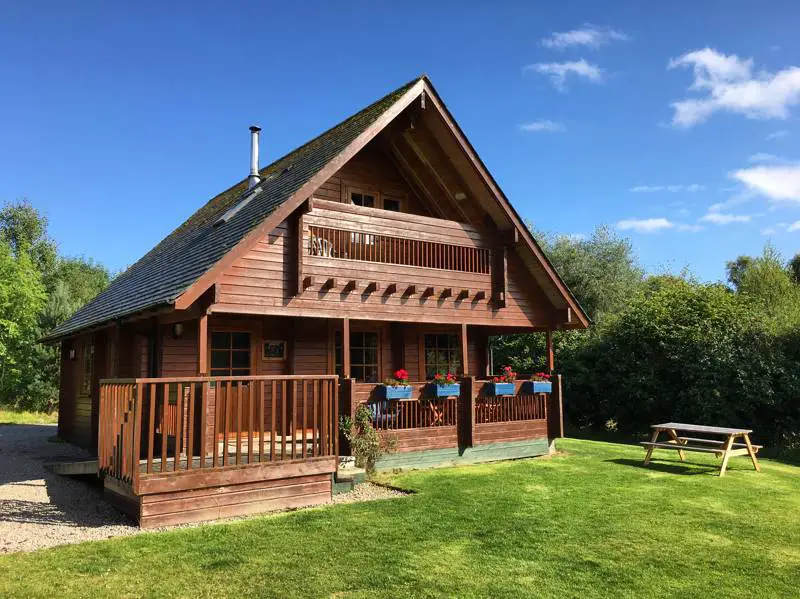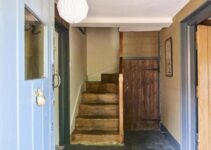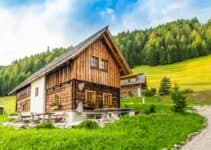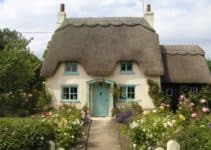We can all picture a cottage in our mind’s eye, can’t we? We’ve been sold the idea of a perfect cottage in art and through the media.
Anything from biscuit tins to the film The Holiday has that delightful image of a small stone-built cottage country dwelling with roses around the door and cat perched on the windowsill.
It’s a popular image that’s even more defined than the dictionary definition: a small house, typically one in the country.
But what is the difference between a cottage vs lodge? The main difference is that a cottage is a small house but a lodge is a building for recreational use. This is the difference in layman’s terms.
A lodge, typically, is a little trickier to define. Let’s look at the original meaning first. Traditionally a lodge was a dwelling for a Lord to stay in temporarily while he hunted.
Later it became a term used to describe a small house on the grounds of a much large house.
Typically the lodge would be located near the entrance gates some way from the main house. A gatekeeper or other servant would be the usual occupant.
Pretty obviously, their job was to open the gates for carriages to enter and shut them to stop unwanted visitors.
But our modern vision of what a lodge actually is might not be so clear-cut as the traditional one. Why? Perhaps because of the explosion in international travel in the last century.
We may have seen snow-covered ski-lodges or chalets in the Swiss Alps or witnessed the cathedral-sized mountain lodges of Colorado. Neither of those are built simply for the servants to live in.

What Makes a House a Lodge?
They key is in the word: lodge. If you use it as a verb rather than a noun you can probably guess that it will refer to the temporary nature of your intended stay.
Lodges, whatever their shape and size, still have that transient quality attached to them, much like a villa.
The servant who is allowed to live in the lodge while they work for the Lord of the manor, the skiers who stay in the lodge for the season, the American family who gather at the lodge for the ‘Holidays’, they’re all staying for a certain time. But it’s not their permanent address.
Can you live in a lodge permanently? Of course you can. It’s just not typical.
What is a Lodge?
Let’s nail it down. I know, bad pun, but it leads into another key aspect of what a lodge is. One of the defining factors is that the construction material is likely to be wood, and a lot of it.
Of course builders might choose different materials, but usually a lodge is a wooden structure – both its frame and exterior.
Don’t be tempted to picture a log cabin here, they are much smaller and, unsurprisingly, made out of logs. So can be we be precise about what a lodge is? Not precise, no, but if the property is wooden and is built with semi-permanence in mind then it’s likely to be a lodge.

What are the differences and similarities between a cottage and lodge?
Now that we have roughly established what a cottage and a lodge is, let’s compare them more precisely.
Location
Where cottages and lodges are sited share some similarities. Both types of homes are typically found in rural environments. Going back to the temporary nature of the lodge, these types of dwellings are linked to working people and making sure they are housed as close to their work as possible.
Where traditional lodges and cottages are located will come down to the kinds of jobs that would have been performed by their inhabitants.
Traditional cottages are generally small and can often be found in agricultural areas. Centuries ago, farmers or small-holders lived in ‘cots’ a humble hut or cottage. This was primarily because they had neither the money or the time to build anything bigger.
If the cottage is now located near a larger farm, it may have been built originally to accommodate farm labourers. As the fields were ploughed, stones would be removed and these could be reused to build dwellings for workers.
A perk of a farm job, in times past, was that if you were a loyal worker you would be allowed to stay in the farm’s ‘tied’ cottage.
The word tied referred to a kind of contract: you got the house only while you worked the job, decide to leave and you lost your home.
Lodges are more likely to be found in forested or mountainous areas. The ease of access to trees as a construction material is clear.
We should also note that the Old English word for lodge is ‘logge’ so the connection to the woodland environment is even clearer.
As far back as the 1200s the same word was being used to describe a temporary dwelling or camp and so we get a clear connection between the construction material and non-permanent function of the lodge.
Workers living there would have been foresters or charcoal burners or linked to game-keeping.
Outside Appearances
In Britain we expect our cottages to look a certain way. While there is no specific architectural specification, cottage exteriors need to have rustic charm.
What this looks like to individuals varies but traditionally a cottage will be built using local stone.
In some cases, and especially if the local stone is poor quality, the outside will be rendered. Traditionally this would be a lime-based compound applied using a 3-coat system. This could then be whitewashed or had a colourant mixed into the whitewash.
From the middle ages this could be pig’s blood. Nowadays, plain white seems to be preferred colour choice for painting rendered stone but more jaunty colours can be found in some rural areas such as Aldeburgh.
Often the roof will be thatched but cheaper tiles are generally used on more modern cottages.
Lodges are recognisable by their used of planked wood. Of course the direction of the planks is a style choice rather than a convention. Modern lodges are just as likely to adopt the fashion for vertical cedar cladding as use the traditional horizontal planking.
The planks themselves are planed and are not the debarked logs that are used to construct their even more rustic cousin, the log cabin.
Lodges can be single or double storied and you’ll see many lodges with balconies, although these are more usually attached to lodges with particularly scenic views.
Through The Keyhole
Cottage interiors are just as likely to have two floors as one, although traditionally they would have been single-storied. In general though, they usually have a smaller floorplan.
In older cottages this might mean only two rooms downstairs and two up, with a lean-to kitchen and an outside lavatory.
These days we prefer to have our comforts on the inside and many old cottages have been renovated or extended. Some cottage interiors can be larger but if your cottage has more the three bedrooms it’s moving into ‘house’ territory.
Lodges in Britain, that are not part of larger country estates, are more likely to have a single story too. For modern properties this could be partly to do with the fact that single-stories in a particular design can be transported.
Transportable properties get around certain British planning laws depending on the area.
Again, there are no specific floor-plan requirements for lodges but they tend to conform to more open communal areas and private sleeping quarters. Open-plan interiors have not been popular in Britain until more recently.
That is if we ignore the mead-halls of Anglo-Saxon England. Rooms in lodges and cottages tended to be smaller in order to retain heat. The need for insulation has not disappeared but for lodges it can depended on the width of the wood used in construction.
Many prefer to retain the rustic look of the wood on the inside as well as out but this may mean cladding the inside and using the cavity to hide utilities.

What Other Difference are There Between Lodges and Cottages?
One of the biggest differences between cottages and lodges is cost. A cabin has a greater sense of permanence and their bucolic charm can demand a higher price from buyers and renters alike.
For people looking to rent out their cottage or lodge or invest in one as a secondary income, it is worth looking close at your likely returns.
Cottages costs more to build and are not transportable. They are often found in sought-after areas and so their acquisition price is higher.
And they are more likely than lodges to be bought as second-homes by high-income families and so require a greater investment.
In Britain, modern-style lodges have become synonymous with holiday lets especially those in larger resorts.
Park and Dean and Center Parcs both offer ‘forest accommodation’ which, more often than not, is a lodge-type property.
The trouble is, lodges were traditionally isolated and these ones are the opposite. They are positioned en masse to maximise rental potential and because of this lose that sense of solace you might expect to find in a woodland location, especially during the summer holidays.
If the lodge is in Scotland then it may be more isolated but may also be aligned with the property prices of those areas.
Typically the average price for holiday lets for lodges is half that for cottages and often much less. So it’s definitely worth considering price if your next property investment comes down to the choice between a cottage or a lodge.
Lodge vs Cottage
Both lodges and cottages offer unique qualities making them ideal retreats for different individuals. Cottages, with their cozy and quaint charm, are perfect for those seeking a serene, homely escape. In contrast, lodges, typically larger and more rustic, are the ideal choice for nature enthusiasts and larger groups.
Ultimately, the choice between a cottage or a lodge depends on one’s personal preferences, the size of the group, and the kind of experience desired. Either way, both provide a chance to connect with nature and escape from the hustle and bustle of everyday life.



